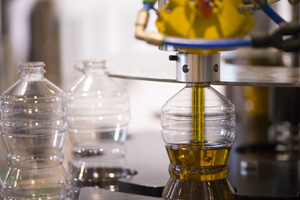
 In many filling applications, a rotary encoder is used for table positioning. Feedback from the encoder helps ensure that the item to be filled is in the correct position prior to activation of the filling mechanism. For example, bottles, tubes, cans or cartons can be transported to a filler via a conveyor, rotary table or other delivery system. The encoder can be mounted to a motor, drive shaft, or another suitable axis. When the proper number of counts is detected, the controller sends a command to activate the fill system. In many designs, the fill process is completed while the containers are still moving.
In many filling applications, a rotary encoder is used for table positioning. Feedback from the encoder helps ensure that the item to be filled is in the correct position prior to activation of the filling mechanism. For example, bottles, tubes, cans or cartons can be transported to a filler via a conveyor, rotary table or other delivery system. The encoder can be mounted to a motor, drive shaft, or another suitable axis. When the proper number of counts is detected, the controller sends a command to activate the fill system. In many designs, the fill process is completed while the containers are still moving.
Augers, rotary fluid dispensers, and peristaltic pumps may utilize encoder feedback. Often other sensors such as vision, proximity or laser, are also used to detect container orientation and container location. Rotary encoders may also be used to control the motion of a fill nozzle or dispenser that needs to be lowered to and withdrawn from the container. Additionally, some filling mechanisms travel in sync with containers as they are transported, and this motion also usually requires encoder feedback.
Mechanically, shaft, thru-bore or measuring wheel encoders can be applied, depending what design is most readily integrated into the system.
Electrically, variables such as resolution, output type, channels, voltage, etc, all should be specified to meet the individual application requirements. While incremental encoders with quadrature output are frequently used, absolute encoders are gaining favor with some machine designers. When powders and other bulk solids are handled, proper attention should be given to static discharge potential and proper grounding and isolation of the encoder.
Environmentally, proximity of the encoder to potential exposure to liquids, fine particulates and extreme temperatures will dictate specification. In filling applications with wash down requirements, an IP66 or IP67 seal can offer protection against moisture ingress. However, consider a stainless steel or polymer composite housing to mitigate the effects of harsh cleaning chemicals and solvents.
Examples: